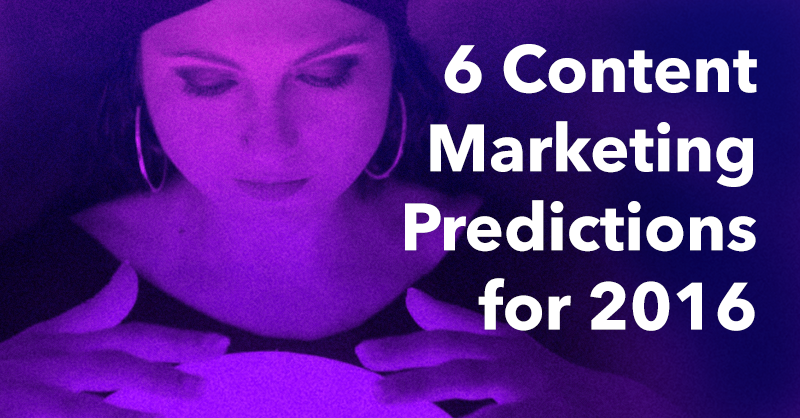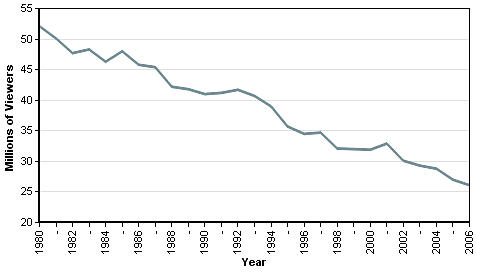
One of this year’s most popular articles highlighted six of my predictions for content marketing in 2015.
While this post wasn’t wholly accurate (who can tell the future perfectly?), a lot of the trends I touched upon did come to pass. What’s even more exciting is that these patterns are now dovetailing in interesting directions. In addition, over the course of the year I’ve noticed completely new movements beginning to materialize.
Instead of highlighting what came to pass from last years post, I want to begin this year by looking ahead towards the year to come and outlining six brand new content marketing predictions for 2016.
Prediction 1: Google+ Will Not Survive
Google+ has been something of a question mark since its hyped introduction over four years ago. A big ambitious project by a company completely qualified to be ambitious has clearly not panned out.
While Google+ certainly has its vocal advocates, its overall user base is vanishing quickly and shows no signs of rebounding.
Just a few weeks ago, the Google+ team announced a total redesign in an attempt to resuscitate the product. While this “pivot” might give aficionados hope, the new set of skin and pared down feature set is a Hail Mary on Google’s part and is too little too late.
The first sign of death for Google+ was flagging membership and activity. However, the biggest blow was the “dis-integration” of Google+ from Google’s other projects that occurred earlier this year.
Hangouts and Photos getting spun off as their own products is also telling of the future outcome of the platform’s demise.
Soon, the dismembered pieces of Google+ will be distributed throughout Google’s product line as their dream of a “fully integrated Google experience” dies a slow, painful death.
I simply don’t see the service lasting through the year. Quote me on that.
Prediction 2: Direct-to-Platform Publishing is Just Getting Started
This year already saw a clear trend emerge as platforms realized that they could disintermediate content and grab more attention and advertising dollars in the process.
Snapchat Discover, Facebook Instant Articles, Google AMP, Twitter Moments LinkedIn Pulse and Apple News are already making waves and disrupting the model of digital publishing.
Even though most of these programs are only in their pilot phases, there are many in the publishing world who are already seeing the writing on the wall (no pun intended!)
Underestimating just how much of a shift this groundswell constitutes will be the death of traditional publishers. As content creators have grown ever more reliant on platforms for traffic, they have relinquished control of their key resource: attention.
Platforms are just beginning to realize that they can take advantage of the readership they generate by integrating content directly instead of pushing people to other properties.
In a previous article this year, I touched upon how content creators can begin to accommodate this change by republishing their content to other platforms, but this is not so much a solution to this underlying problem as much as it is a stop-gap measure.
2016 will see this trend further disrupt the publisher/platform relationship and more power will be clearly given to the platforms. The only way for publishers to re-assert control will be to devise a way to build and engage an audience within a given platform and to foster loyalty that translates outside the properties where their content is living and being consumed.
Prediction 3: Facebook Will Play a Bigger Part in Dictating the Tone of the 2016 Elections
In both the primaries and global politics, Facebook’s trending topics have helped shape and define the discussion and the sentiment surrounding world affairs. Media outlets used to set the tone, but now the opposite is true.
A 61-million person study published in Nature in 2012 found that Facebook use and exposure to certain ideas could have a “significant influence” on voting behaviors.
Not only has Facebook’s core user-base increased dramatically in the years since 2012, but the amount of time spent on the site and the degree to which content users see has become polarized have increased as well. Outrage and strong opinions abound as “social subcultures” begin to reinforce the echo-chamber effect and help spread virulent messages quickly throughout the social media sphere of influence.
The media is complicit in helping to spread and leverage this outrage, all while riding the wave of the emotional response these flashpoint posts are almost guaranteed to garner.
Being able to harness such strong emotions is risky, but content that does so responsibly can achieve dramatic social lift. In the coming months, brands will not be able to stay relevant and stay neutral at the same time. Your brand will be forced to choose a point-of-view and embrace it, so make sure to choose carefully.
Prediction 4: Emerging Destinations of Content will Continue to Pull Viewers Away from Traditional Publishers and Channels
Mass-market, multi-media content is experiencing a precipitous decline.

Certain networks have escaped this fall by doubling down on quality and tightening their appeal, but there is only so much room for established, traditional publishers like the Atlantic, the New Yorker, CBS, CNN and others, and the new economic realities of content distribution mean there is even less money to go around to support such programming.
At the other end of the spectrum, though, are the independent podcasters, YouTubers and bloggers that are eschewing large budgets and mass-appeal by narrowly defining their audience and catering directly to their needs.
The rise of social subcultures has facilitated this diffusion of attention across various channels.
This has led to the unique class of “superstars you’ve never heard of” who have outsized influence in small-sized communities. Although they might not be household names just yet, some of these high-profile social celebrities are beginning to have mainstream impact. In January of this year; YouTubers Bethany Mota, Hank Green, and GloZell Green were all invited to the White House to interview Obama, live and with questions sourced directly from their passionate fanbases.
The fact that a couple of young, non-connected, independent creatives were able to get the type of access once only open to the Barbra Walter’s and Walter Cronkite’s of the world should tell you more about this trend than any facts or figures can.
Although content creation has become decentralized and budgets are falling, there is still money to be made here. That’s because the value of this hyper-focused attention is so much more per-capita than the fraction-of-a-penny per eyeball that most mass media relies on.
Certain brands are focusing on creating strategic partnerships with independent creators that align with their unique audience. Just look at what Squarespace has done with their podcast sponsorships or how Audible has allied with relatively small YouTubers like Minute Physics and Veritasium.
Other brands are taking a different approach whereby they bring this type of small-scale, hyper-targeted content creation in-house. This lines up with the prediction I made last year regarding brands becoming publishing houses and the most notable example of this panning out in 2015 is the amazing work Marriot has done with their online publication Marriott Traveller and what Harry’s razors has done with their publication Five O’ Clock.
These established and emerging outlets by independent creators, brands and other players will continue to disperse the attention of consumers, limiting the reach and influence of traditional publishers.
Prediction 5: Content will Get Easier to Produce and Harder to Stand Out With
2015 has been a defining year for Snapchat and Instagram, but 2016 will be the year they truly mature.
On the one hand, you have the emergence of high-quality catered content that is being produced by relatively few individuals for their narrowly defined audiences (see previous prediction). On the other hand you have networks that encourage a very large percentage of users to create low-effort, fleeting content.
What this content lacks in polish it makes up for in spontaneity, relevance and timeliness. Images and short video are the perfect media for this type of content and having said content disappear (be it within an unsearchable ever-updating stream or in a self-destructing post) helps encourage sharing without overthinking.
Snapchat and Instagram are the perfect environments for such content, and both are just figuring out how to improve and monetize.
The challenge this presents to brands though is that it makes standing out with content difficult, and means that your content needs to be a constantly flowing stream just to stay on your customer’s radar.
Brands that will be the winners in this space will be those who can create processes that guarantee a consistent rhythm for delivering highly visual, impactful and spontaneous content. This will likely require that you forgo some degree of quality as you attempt to balance spontaneity with effective planning.
Prediction 6: Chat Apps will Catch on Stateside in a Bigger Way
In many other regions of the world, chat apps such as WhatsApp, Line, Telegram and WeChat are seeing massive user-bases and phenomenal growth. However, growth in the US has been strong but not as dramatic. 2016 is the year that all of this will change.
Facebook Messenger and WhatsApp have shown that there is mainstream appeal for instant messaging apps in the US, but they have not yet fully matured as their own distinct platforms.
In a post earlier this year, I took a detailed look at messaging apps and exactly what made them such a promising venue for future growth in the digital marketing sector.
One particularly compelling statistic was that the growth of mobile chat apps had doubled the average growth-rate of new mobile users.
This alone makes chat apps promising, but the most exciting opportunity for chat apps comes in solving the problem presented in the previous prediction.
As general, user-generated, short form visual content becomes ever more difficult to stand out in, one thing that could give brands a way to be noticed is a new delivery channel.
Instead of hoping to have your content delivered in-feed, you can use the chat features of these apps as direct lines to tailored audiences in specific groups. This is the general idea behind the wildly popular Snapchat Discover, and the addition of sponsored content will likely be the avenue towards monetization for many other chat apps.
Although the parameters for how to market in this emerging medium are still being drawn, savvy marketers will know to closely watch the chat app space and be waiting to jump on the opportunity to leverage this new channel once it presents itself more clearly.
Which of my predictions on content marketing for the coming year do you agree with and which do you think I missed the mark on? Share your input in the comments below.


